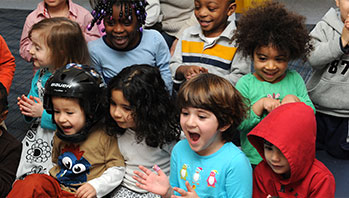- name cards
MA Standards:
Speaking and Listening/
SL.PK.MA.1a: Observe and use appropriate ways of interacting in a group (e.g., taking turns in talking, listening to peers, waiting to speak until another person is finished talking, asking questions and waiting for an answer, gaining the floor in appropriate ways).
RF.PK.MA.3.c: Recognize one’s own name and familiar common signs and labels (e.g., STOP).
Head Start Outcomes:
Social Emotional Development/Self-Regulation: Follows simple rules, routines, and directions.
Language Development/Receptive Language: Attends to language during conversations, songs, stories, or other learning experiences.
PreK Learning Guidelines:
English Language Arts/Language 1: Observe and use appropriate ways of interacting in a group (taking turns in talking; listening to peers; waiting until someone is finished; asking questions and waiting for an answer; gaining the floor in appropriate ways).
English Language Arts/Reading and Literature 12: Listen to, recite, sing, and dramatize a variety of age-appropriate literature.
Greeting Song: “Where Is?” #7

© Commonwealth of Massachusetts, Department of Early Education and Care (Jennifer Waddell photographer). All rights reserved.
ELA Focus Skills: Name Recognition, Phonological Awareness, Speaking and Listening
Tell children you are going to sing “Where Is?” to them again.
Explain that this time, instead of singing a child’s name you are going to hold up a name card after singing the line “Where is . . . .”
- Say, I will hold up a name card and look right at the child who's name is on the card.
- Then have the child's whose card you are holding up say his or her name and then "Here I am!"
Demonstrate with volunteer and then continue until you have acknowledged each child. Encourage the group to sing the song with you.
Where Is?
(sung to the tune of “Frère Jacques”)
(educator)
Where is <child’s name>?
Where is <same child’s name>?
(child/ren)
Here I am.
Here I am.
(educator/children)
We’re glad that you are with us,
So glad that you are with us,
Smile and wave.
And now sit down.
Educator's Tip: Assure children who are unable to read their name in print that that you will tap them or send them a signal if they don't realize you are looking at them.
